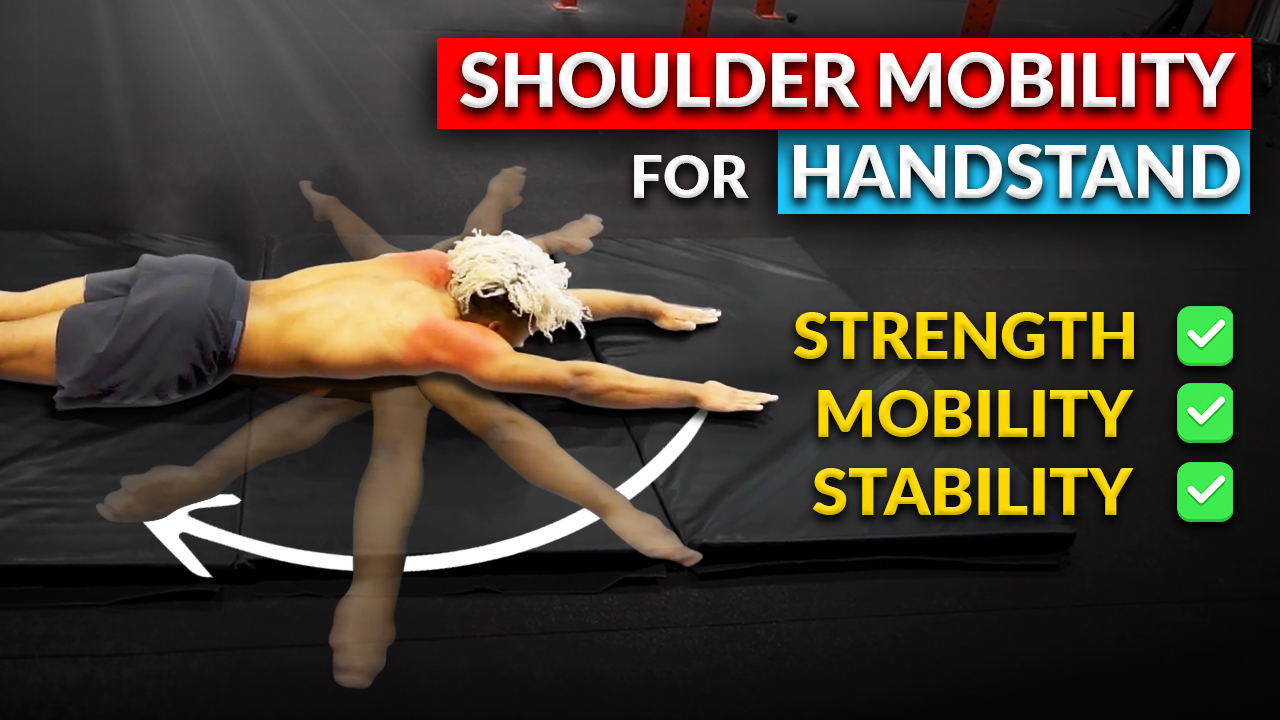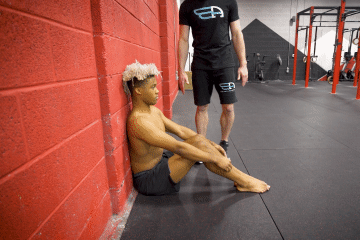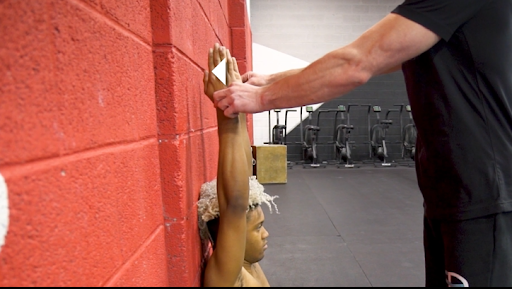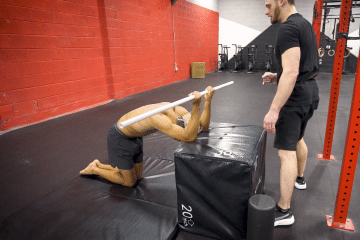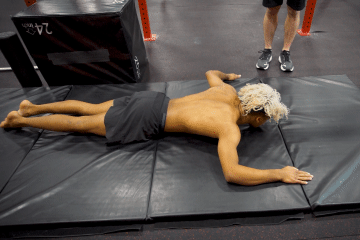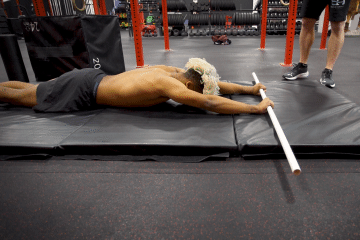Have you ever been captivated by the flawless beauty of a handstand that gracefully defies the laws of gravity?😱😱
Perhaps you’ve tried it yourself and felt the exhilaration of being upside down, even if only for a moment. But mastering the art of handstands is no easy feat. It demands balance, strength, and, as we’re about to discover, an essential element: overhead shoulder mobility.
👉Picture this: you’re on your handstand journey, exploring handstand shaping, core strength, and wrist preparation. You’re getting closer to the perfect handstand. But something’s missing, and that something is your shoulders. They’re the conductors of this symphony, directing your ascent into balance and grace.
Without proper shoulder mobility, your handstand could resemble a banana. That’s not the picture-perfect performance you’re aiming for, is it?😢
In this article, we will explore the world of handstands and the crucial role played by your shoulders. Let’s delve into the essential drills and exercises that can work wonders for your shoulder mobility, empowering you to achieve a flawless handstand effortlessly and with a touch of style.
🔥Understanding Overhead Shoulder Mobility
Overhead shoulder mobility refers to the ability of the shoulder joint to move comfortably and effectively in an overhead or elevated position. This movement is essential for various activities that involve reaching, lifting, or performing tasks above shoulder level, including handstands. Handstands are a prime example of a movement that heavily relies on overhead shoulder mobility.
🔐Key aspects of overhead shoulder mobility, which are crucial for performing successful handstands, include:
- 🎯Raising the Arm: Raising your arm overhead, as if reaching for something on a high shelf or achieving an elevated handstand position, without discomfort or restriction.
- 🎯Flexibility: Adequate flexibility in the shoulder joint and the surrounding muscles and tendons is essential for executing a handstand. This includes extending the arm and externally rotating the shoulder to balance the body weight on the hands.
Helpful article: 📍5 Most Effective Exercises to Stretch Your Shoulders
- 🎯Strength: While flexibility is vital, strength plays a significant role in handstand execution. The muscles of the shoulder, particularly the deltoids and the core muscles, must be strong enough to support the body weight while in an inverted position.
Check out this helpful article on 📍The Worst Calisthenics Shoulder Exercises for Shoulder Strength and Muscle Growth
- 🎯Stability: Handstands demand exceptional shoulder joint and core muscle stability to maintain balance and prevent injuries. Proper engagement of the rotator cuff muscles and scapular stability are critical.
- 🎯Range of Motion: A full range of motion in the shoulder joint is crucial for handstands. It allows for controlled movement and alignment of the body during this demanding exercise.
- 🎯Posture: Correct posture and body alignment are vital for successful handstands. Proper posture and scapular positioning are essential to maintain balance and minimize shoulder strain.
Restricted overhead mobility can lead to shoulder pain, limited performance, and an increased risk of injury in these activities.
Failing to achieve a full 180-degree overhead range compromises the integrity of your handstand. This limitation often leads to the infamous “banana back” shape. It forces you to compensate for the reduced shoulder mobility by adopting an awkward angle, making it challenging to maintain a straight and stable handstand.
To improve overhead shoulder mobility for handstands and other activities, people exercise and stretch their shoulders, chest, upper back, and core. Proper technique, balance, and posture are essential when practicing handstands, and addressing any postural issues that may limit mobility is key to success.
💥7 Essential Shoulder Mobility Exercises for Handstand
Here are seven essential shoulder mobility exercises that can help improve your overhead mobility and are particularly beneficial for those aiming to perform handstands:
1. ☑️ Overhead Screening for Shoulder
Performing the overhead mobility screening for your shoulders is an essential step to assess your readiness for handstands. Using a wall as a vertical reference, aim to align your body with it.
Begin by sitting against the wall, ensuring your lower back, shoulders, and head are in contact with it. Your goal is to mimic the handstand position, lifting your arms upward.
The objective is to check if you can reach the wall with your arms fully extended in a 180-degree position. Any difficulty or tightness might indicate shoulder weakness or lat tightness.
This exercise highlights the difference between passive assistance and active flexibility. When someone assists you, it can seem easier, but trying to maintain the position independently can be more challenging.
Remember that even if you can do a handstand in a 180-degree position on the floor, this wall exercise can be more demanding because you don’t have any external support to push against. It solely relies on your muscle strength to maintain the position without assistance. This screening helps identify areas for improvement in your shoulder mobility for handstands.

2. ☑️ Overhead PVC Pipe Stretch
One common limitation in overhead mobility is the flexibility of the lats (latissimus dorsi muscles).
To address this, you can do the overhead PVC pipe stretch. Hold a PVC pipe with an underhand grip. Ensure your elbows align with your shoulders, and keep your torso slightly rounded. While doing so, sit your glutes toward your heels. In this position, you should feel a stretch in your lats.
If you don’t experience this lat stretch and you’re executing the position correctly, it may not be one of your limitations. However, this stretch will provide a significant release in the lats for most individuals.
By including the overhead PVC pipe stretch, you can target the lats and work to increase your shoulder mobility, a crucial element for improving your handstand practice.
3. ☑️ Foam Rolling with Lats
Now, let’s work on isolating the upper thoracic area. Engaging in foam rolling exercises for the lats can significantly benefit your shoulder mobility for handstands.
By targeting the lats and upper back muscles, this exercise helps increase flexibility and mobility in these crucial areas. With improved lats and upper back mobility, you’ll find it easier to reach overhead positions, an essential skill in successful handstand practice.
Place a foam roller under your knee to eliminate lower body movement. Make a semi-circle motion with your hand, ensuring it maintains contact with the floor throughout the movement. This exercise helps improve the flexibility of your upper back and shoulders.
It allows you to isolate the upper thoracic area, promoting flexibility and mobility in your lats and upper back muscles. Incorporate this exercise regularly to enhance overall shoulder mobility, contributing to handstand practice and upper body strength and flexibility.
4. ☑️ Thoracic Rotations
Thoracic rotation is a powerful exercise for enhancing shoulder mobility for successful handstand practice. By focusing on the upper back and thoracic region, this exercise promotes increased flexibility and mobility in the shoulders, directly contributing to better control and stability during handstands.
Place a foam roller under your knee, ensuring that you’re isolating the upper thoracic area and preventing any movement from the lumbar or lower body.
Start with your hands together, palm to palm. You aim to create a semicircle motion with your hands, maintaining contact with the floor throughout the entire movement.
As your hand touches the floor, keep your attention on it and watch as it guides you through the motion. Once you reach a specific position, gently fold back over and repeat the motion.
Remember that performing this exercise on both sides is essential for comprehensive results. Regularly practicing thoracic rotation can enhance upper back mobility and shoulder range of motion, benefiting your handstand skills and overall upper body strength and flexibility.
5. ☑️ Pec Stretch
Tight pectoral muscles can also restrict overhead mobility. This pec stretch is an excellent way to alleviate tightness in the pec muscles, ultimately promoting a better overhead range of motion.
Lie on your stomach and extend one arm to the side at a 90-degree angle. The elbow should align with the shoulder, and the forearm should face forward. Gently roll your torso toward the extended arm, feeling the stretch in your chest muscles. Repeat for both sides.
6. ☑️ Prone Stick Lifts Overhead
Another valuable exercise to consider is the prone stick overhead lift. This exercise not only aids in enhancing your shoulder mobility but also strengthens the anterior deltoids and upper back muscles.
To perform the prone stick overhead exercise, lie face-down with arms straight and hands at shoulder width. Lift the stick slowly and deliberately, avoiding spinal assistance or arching. Aim for 10 reps, and challenge yourself with a 10-second hold on the last one.
It resembles other overhead mobility exercises and helps isolate and work the anterior deltoids and upper back muscles.
To add to your arsenal of shoulder mobility exercises, consider including floor angels and wall angels. They’re great complements to the prone stick overhead exercise.
While floor angels involve moving your arms and hands through a semicircular range of motion without touching the floor, wall angels utilize the wall as a reference point for controlled movements.
These exercises and the prone stick overhead lift will significantly contribute to your shoulder mobility for handstand practice. Building strong and flexible shoulders is key to achieving and maintaining a successful handstand.
7. ☑️Negative Chin-Ups
Lastly, consider negative chin-ups for strengthening the lats. Start in a supine dead hang position, feeling the stretch in your lats. Slowly lower yourself down, emphasizing control and stretching the lats as you descend.
Your lat muscles lengthen as you descend, and you can feel the stretch through your shoulders. This controlled descent is crucial, as you’re actively stretching and strengthening your lats while promoting shoulder flexibility, making it a valuable exercise for your handstand training.
Related articles:
📍5 Most Effective Exercises to Stretch Your Shoulders
📍6 Simple Tips to Avoid Shoulder Injury
Here’s the full video on the 7 essential shoulder mobility drills for handstands:
📌Importance of Overhead Shoulder Mobility in Handstands
Improve shoulder mobility with targeted stretches and exercises for a safe and effective handstand practice. Overhead-shoulder mobility is essential for handstands due to the following:
- ✅ It ensures balance and stability by aligning your shoulders over your wrists.
- ✅ Distributes weight evenly, maintaining a straight line from wrists to hips.
- ✅ Reduces strain on shoulder and wrist joints.
- ✅ Supports efficient movements and adjustments.
- ✅ Prevents injuries by avoiding compensatory movements.
- ✅ Enables progression to advanced handstand skills.
🧐Frequently Asked Questions:
🔎What are overhead shoulder mobility drills for handstands?
Overhead shoulder mobility drills are exercises designed to improve your shoulder joints’ flexibility, strength, and range of motion. These drills are essential for achieving and maintaining proper handstand positions.
🔎Why is overhead shoulder mobility important for handstands?
Adequate overhead shoulder mobility is crucial for handstands, allowing you to reach your arms overhead while maintaining stability. It enables you to balance your weight effectively and perform handstands with better control.
🔎How often should I incorporate overhead shoulder mobility drills into my routine?
The frequency of these drills depends on your current level of shoulder mobility. However, it is generally recommended to include them in your regular warm-up or cool-down routines. Aim for consistency, and gradually increase the intensity or duration of the exercises as your mobility improves.
🔎Can anyone benefit from overhead shoulder mobility drills, even if they’re not into handstands?
Absolutely. While these drills are essential for handstand practitioners, they can benefit anyone looking to improve their shoulder mobility, reduce the risk of injury, and enhance overall upper body flexibility. They are valuable for many physical activities, not just handstands.
🔎Are there any precautions I should take when performing these drills?
It’s essential to start with proper form and avoid pushing your shoulders beyond their current range of motion. If you have a history of shoulder issues, consult a healthcare professional or a certified trainer before beginning a new mobility routine to ensure it’s safe for you.
🔎Can I combine overhead shoulder mobility drills with other exercises?
Yes, you can incorporate these drills into your broader fitness routine. Combining them with core and balance exercises can help you develop a well-rounded foundation for handstands. Just be mindful of not overloading your shoulders, and ensure you maintain proper form throughout.
🔎How long does it take to see improvements in overhead shoulder mobility?
The timeline for improvement varies from person to person. You may notice some improvements in a few weeks with consistent practice, but significant progress typically occurs over several months. Patience and regular practice are key to long-lasting results.
🔎Can I use household items as substitutes for specialized equipment in these drills?
Many overhead shoulder mobility exercises can be adapted using everyday household items. For example, a broomstick or a rolled-up towel can be used instead of a PVC pipe or foam roller. These makeshift tools can help you get started without needing specialized equipment.
💥Conclusion
Shoulder mobility is a crucial element when it comes to conquering handstands.🤸 The various exercises mentioned can help address any limitations you might face. Prioritizing your shoulder mobility is the foundation for achieving the right shoulder angle, essential for successful handstands.
Keep in mind that the handstand journey is an ongoing process. Whether you’re just starting or looking to refine your handstand skills, these exercises can significantly impact your progress.💯
If you’re ready to embark on this journey but unsure where to begin, Take a Free Assessment with The Movement Athlete. It provides a personalized training program to set you on the right path.

